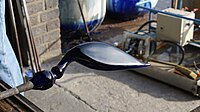Bristol blue glass

Bristol blue glass has been made in Bristol, England, since the 18th century, with a break between the 1920s and 1980s.
History
During the late 18th century Richard Champion, a Bristol merchant and potter, making Bristol porcelain, was working with a chemist, William Cookworthy.[1] Cookworthy began a search for good quality cobalt oxide to give the blue glaze decoration on the white porcelain and obtained exclusive import rights to all the cobalt oxide from the Royal Saxon Cobalt Works in Saxony.[2] It is uncertain when Bristol blue glass was first made but the quality and beauty of the glass swiftly gained popularity, with seventeen glass houses being set up in the city.[3]
Lazarus and
Production ceased in about 1923.[6]
Revival
Around 1970 Thomas Webb & Sons of Stourbridge made a range of about ten Bristol blue glass shapes, but had to stop as they found cobalt dust was contaminating their lead crystal. At the request of John Stott, the managing director of Thomas Webb (who closed down in 1990), Nazeing Glass of Broxbourne, Herts, supplied the Bristol Museum and Art Gallery Shop with a range of some twenty glass shapes, all based on 18th century inspired designs, from 1975 until 1990. Bristol-based glass makers James Adlington and Peter Sinclair held their Hot Glass exhibition in 1988 at Hand Made Glass, Bristol, which led to a revival of Bristol's hand blown glass industry, and to the creation of a company that has spawned the careers of many other studio glassmakers in the southwest of England.[7] Today, Bristol Blue Glass is produced by The Original Bristol Blue Glass Ltd in Brislington, established in 1988.
In the 1990s, John Harvey & Sons of Bristol began to sell Bristol Cream sherry in bottles made from Bristol blue, after a period of over 100 years during which blue bottles had been associated with the sale of dangerous or poisonous liquids.
Production
-
Bristol blue glass heron body
-
Bristol blue glass heron base
-
Bristol blue glass heron. Beak being pulled into place
-
A stage in the manufacture of a Bristol blue ship’s decanter
Chemical composition
The glass contains cobalt oxide, which creates a deep yet bright blue, and 24% lead oxide (PbO).[8]
See also
References
- ^ "Bristol Blue Glass". Business West. Archived from the original on 30 September 2007. Retrieved 1 September 2007.
- ^ Weeden, C. (December 1990). "William Cookworthy and Bristol blue glass". Glass Technology. 31: 256–65.
- ^ "History of Bristol Blue Glass". Bristol Blue Glass USA. Archived from the original on 9 June 2007. Retrieved 1 September 2007.
- ^ Madge Dresser, ‘Jacobs, Isaac (1757/8–1835)’, Oxford Dictionary of National Biography, Oxford University Press, 2004; online edn, Jan 2008 accessed 29 July 2016
- ^ "Heritage". Bristol Blue Glass. Archived from the original on 29 September 2007. Retrieved 1 September 2007.
- ^ The History of Bristol Blue Glass Archived May 18, 2011, at the Wayback Machine. Accessed 23 May 2011
- ^ "About Bristol Blue Glass". Archived from the original on 7 January 2012. Retrieved 21 December 2011.
- .




